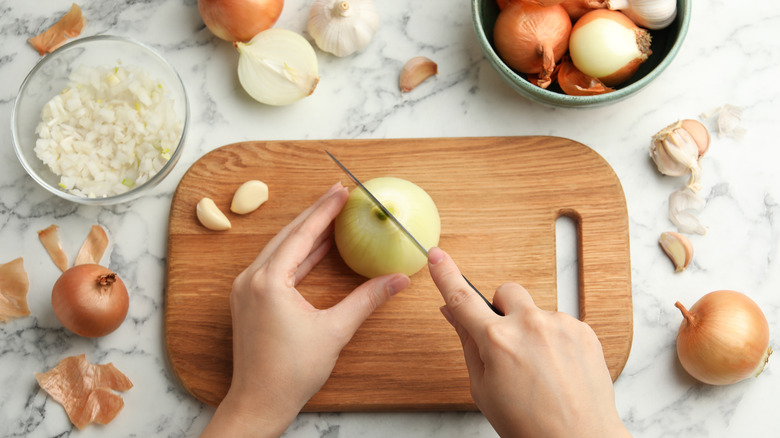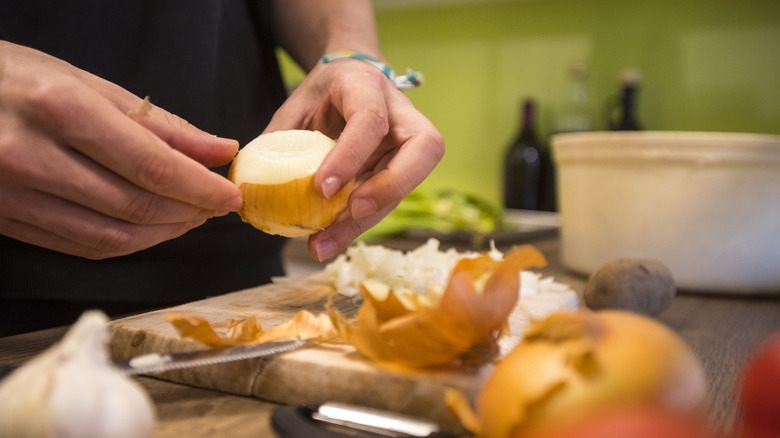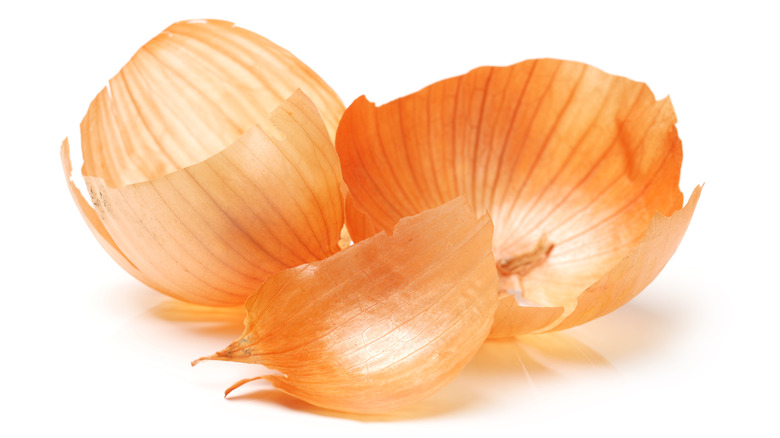The Onion Peeling Hack You Already Know But Aren't Using
The smell of onions sizzling in a pan heralds the start of many wonderful meals. Onions enhance flavor and nutrition since they are chock-full of antioxidants and antibacterial compounds. Humans have been eating onions for thousands of years, states the National Onion Association – and on Gastropod, microbiologist Rob Dunn explains an experiment indicating that alliums (onions and relatives like garlic, chives, and shallots) may even be able to slow food spoilage, explaining why we began eating these potent orbs in the first place.
But the downside is that onions are a labor-intensive ingredient. You must chop them up carefully; possibly with protective equipment, make sure you cook them at the right temperature for the desired effect, and before you do all that, you have that befuddling skin to deal with. It's the onion's protective layer and it works wonders against insect pests and home cooks alike. The good news is that you probably already know the fastest way to peel an onion — you just haven't done it yet.
The power is in your hands
You know the frustration of trying to remove the fiddly outer layer of an onion even though it handily doubles as natural packaging, allowing for long-term storage (per FoodPrint). Cutting the ends off the onion definitely helps peel it, but the pro move is to slice your onion in half, place it cut-side down, and hit it with your fist, according to First For Women. It's similar to whacking garlic cloves with the flat of your kitchen knife.
One thing to consider is the direction in which you halve the onion initially. For onions that break down quickly, like caramelized onions, cut your onion from end to end, per Splendid Table. For crisper onions — like for sandwich toppers — slice them equatorially. Also, be sure to strike down onto the onion — you don't want to wind up launching it somewhere it's not supposed to go or thrust your cutting board into hazards nearby. You want a solid, controlled hit. A cutting board with grippy feet is useful.
Save the peels
Once you've successfully peeled your onion, don't throw the peels in the trash! Farmer's Almanac reports that onion peels are rich in antioxidants and vitamins A, C, and E — a great addition to dishes like soups, stocks, and even rice. Just be sure to opt for onions that have not been sprayed with pesticides if you're planning on using the skins and remove them before eating, the site adds.
According to the Natural Resources Defense Council, about 40% of the food we buy is wasted. That's an eye-watering amount, considering how many of the fruits and vegetables we regularly consume are nearly entirely edible, not just the parts commonly sold at the store. Practicing so-called "root to stem" cooking — nose-to-tail's plant-based cousin — can help reduce food waste, says The Diabetes Council. You can also compost onion peels along with your other produce scraps. Clearly, onions are more than the butt of "Shrek" jokes. They may make us cry — but instead of looking at hitting them as retaliation, think of it as an appreciative pat on the back for a job well done.


